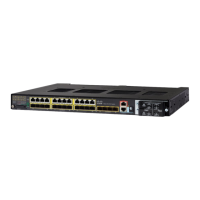59
Cisco Systems, Inc. www.cisco.com
Performing Switch Setup Configuration
Restrictions for Performing Switch Setup Configuration
The DHCP-based autoconfiguration with a saved configuration process stops if there is not at least one Layer 3
interface in an up state without an assigned IP address in the network.
Unless you configure a timeout, the DHCP-based autoconfiguration with a saved configuration feature tries
indefinitely to download an IP address.
The auto-install process stops if a configuration file cannot be downloaded or it the configuration file is corrupted.
Note: The configuration file that is downloaded from TFTP is merged with the existing configuration in the running
configuration but is not saved in the NVRAM unless you enter the write memory or copy running-configuration
startup-configuration privileged EXEC command. Note that if the downloaded configuration is saved to the startup
configuration, the feature is not triggered during subsequent system restarts.
Information About Performing Switch Setup Configuration
This chapter describes how to perform your initial switch configuration tasks that include IP address assignments and
DHCP autoconfiguration.
Switch Boot Process
To start your switch, you need to follow the procedures in the Hardware Installation Guide Hardware Technical Guide for
installing and powering on the switch and for setting up the initial switch configuration (IP address, subnet mask, default
gateway, secret and Telnet passwords, and so forth).
The normal boot process involves the operation of the boot loader software, which performs these activities:
Performs low-level CPU initialization—Initializes the CPU registers, which control where physical memory is mapped,
its quantity and its speed.
Performs power-on self-test (POST) for the CPU subsystem—Tests the CPU DRAM and the portion of the flash device
that makes up the flash file system.
Initializes the flash memory card file system on the system board.
Loads a default operating system software image into memory and boots up the switch.
The boot loader provides access to the flash file system before the operating system is loaded. Normally, the boot loader
is used only to load, uncompress, and launch the operating system. After the boot loader gives the operating system
control of the CPU, the boot loader is not active until the next system reset or power-on.
The switch supports a flash memory card that makes it possible to replace a failed switch without reconfiguring the new
switch. The slot for the flash memory card is hot swappable and front-accessed. A cover protects the flash card and
holds the card firmly in place. The cover is hinged and closed with a captive screw, which prevents the card from coming
loose and protects against shock and vibration.

